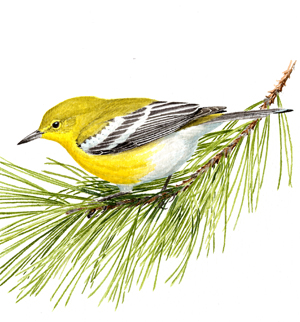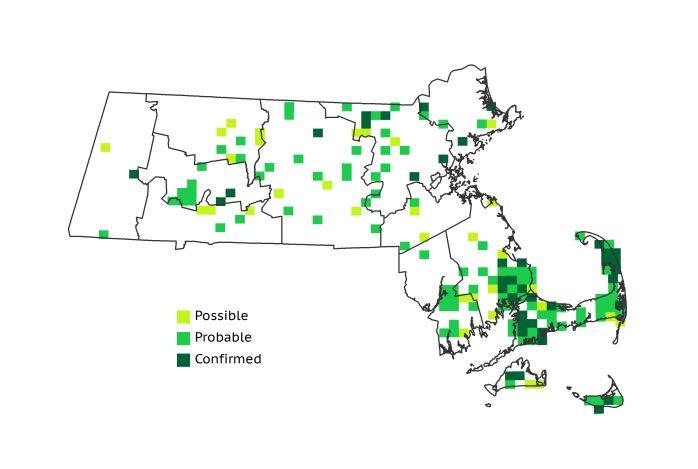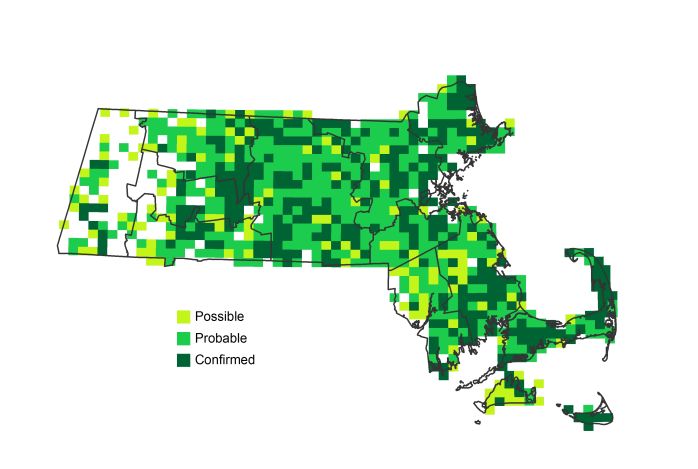Find a Bird
Pine Warbler
Dendroica pinus

Very widespread and strongly increasing
“While the Pine Warbler has one of the most extended breeding ranges among Warblers, it is never found nesting in other than pines, and even during its migrations it is seen in other growths with comparative infrequency.” – Frank M. Chapman, The Warblers of North America
As its name suggests, the Pine Warbler typically shuns deciduous woods or high-altitude stands of spruce and fir. Rather, it goes where the pines are, and pre-Colombian Massachusetts certainly had plenty of pines. Tall White Pines, intermixed with resinous Red Pines, covered large portions of the state. Gnarled but venerable Pitch Pines dominated the sandy forests of Cape Cod and the Islands. Of course, after the arrival of colonists, homes and farms sprang up as the trees went down. Even as acres upon acres of pine forest disappeared across the state, Pine Warblers persisted for many years on Cape Cod.
Historic Status
Historical data on nongame birds or species not thought of as agricultural “pests,” those with little perceived economic value either positive or negative, is relatively scant. Many of the warblers and sparrows suffer from this phenomenon in the historic literature – they were just not carefully studied. Brewster noted that during migration this warbler could be found in “apple orchards and even in city gardens,” but was “seldom seen far from the trees from which it takes its name,” (Brewster 1906). The Pitch Pines of southeastern Massachusetts have long provided a home for Pine Warblers, but land use changes led to the destruction of much of this habitat.
Atlas 1 Distribution
In Atlas 1, the aptly named Pine Warbler could be found in a nearly opposite distribution to many of the high-altitude warblers, and was limited to only 17% of the blocks in the state. The northern hardwood and spruce-fir forests in the western part of the state hosted few Pine Warblers. Not until the Berkshire Transition – an area where northern hardwoods begin to give way to mixed forests – did Pine Warblers begin to increase block occupancy. Pine Warblers were also sparingly present throughout the Connecticut River Valley and the Worcester and Lower Worcester Plateaus. In the Coastal Plains, there were 34 occupied blocks, 21% of their statewide footprint – as many blocks as all other ecoregions west of that region combined. The Bristol/Narragansett Lowlands also supported quite a few Pine Warblers, but the species’ primary stronghold was on Cape Cod. The Pitch Pine forests of the Cape and Islands had little timber value, but were of considerable value to the Pine Warbler.
Atlas 2 Distribution and Change
Pine Warblers are short-distance migrants, and unlike many other warblers they are fairly frequent patrons of feeding stations throughout the southeastern US during the fall and winter months. This, along with the burgeoning stands of maturing pasture pines and abandoned pine plantations across the state, almost certainly contributed in part to the extraordinary success of this species during the inter-Atlas period, and they posted an astonishing 78% block occupancy statewide. They increased in every region of the state in Atlas 2, and while those increases were smaller in the higher regions of the Commonwealth, (e.g., the Taconic Mountains and Berkshire Highlands), the proliferation of the species through central and eastern Massachusetts more than made up for the difference. Every region from the Connecticut River Valley eastward reported Pine Warblers in at least 60% of the blocks, with many regions having more than 90% occupancy.
Atlas 1 Map

Atlas 2 Map

Atlas Change Map

Ecoregion Data
Atlas 1 | Atlas 2 | Change | ||||||
Ecoregion | # Blocks | % Blocks | % of Range | # Blocks | % Blocks | % of Range | Change in # Blocks | Change in % Blocks |
Taconic Mountains | 0 | 0.0 | 0.0 | 3 | 12.0 | 0.4 | 2 | 13.3 |
Marble Valleys/Housatonic Valley | 2 | 5.1 | 1.2 | 26 | 66.7 | 3.2 | 24 | 61.5 |
Berkshire Highlands | 1 | 1.8 | 0.6 | 17 | 30.9 | 2.1 | 15 | 28.3 |
Lower Berkshire Hills | 0 | 0.0 | 0.0 | 14 | 45.2 | 1.7 | 13 | 48.1 |
Vermont Piedmont | 0 | 0.0 | 0.0 | 14 | 82.4 | 1.7 | 9 | 75.0 |
Berkshire Transition | 5 | 13.2 | 3.0 | 23 | 57.5 | 2.8 | 11 | 35.5 |
Connecticut River Valley | 8 | 14.3 | 4.8 | 53 | 81.5 | 6.6 | 36 | 75.0 |
Worcester Plateau | 9 | 11.5 | 5.5 | 86 | 97.7 | 10.6 | 39 | 81.3 |
Lower Worcester Plateau | 9 | 12.2 | 5.5 | 75 | 93.8 | 9.3 | 45 | 83.3 |
S. New England Coastal Plains and Hills | 34 | 12.6 | 20.6 | 260 | 91.9 | 32.2 | 177 | 78.3 |
Boston Basin | 3 | 5.4 | 1.8 | 35 | 62.5 | 4.3 | 32 | 58.2 |
Bristol and Narragansett Lowlands | 22 | 20.8 | 13.3 | 94 | 82.5 | 11.6 | 67 | 66.3 |
Cape Cod and Islands | 72 | 52.9 | 43.6 | 108 | 75.0 | 13.4 | 22 | 18.3 |
Statewide Total | 165 | 17.0 | 100.0 | 808 | 77.9 | 100.0 | 492 | 59.3 |
Notes
The Pine Warbler shows a significant increasing Breeding Bird Survey trend for Massachusetts, the New England/Mid-Atlantic Region, and the Eastern US overall.



